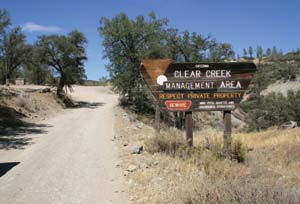
The release of an administrative plan concerning the Clear Creek
Management Area has spurred a flurry of controversy between
off-road vehicle users and environmentalists, and placed the Bureau
of Land Management in the middle.
The release of an administrative plan concerning the Clear Creek Management Area has spurred a flurry of controversy between off-road vehicle users and environmentalists, and placed the Bureau of Land Management in the middle.
For the past 30 years, Clear Creek has become one of the premier spots for off-highway vehicle (OHV) users to participate in their sport.
But a BLM management plan released to the public Thursday could soon limit the surplus of routes and trails available to them because of growing environmental concerns and pressure from environmentalists.
The plan outlines several alternatives concerning activities at Clear Creek, including an alternative to enhance recreation, enhance resource protection and a no action alternative, according to George Hill, assistant field manager at the BLM Hollister Field Office.
The BLM attempted to implement a management plan in 1998, but didn’t follow through. That non-action prompted both OHV groups and environmentalists to threaten to file lawsuits.
And the newest effort has been met with further resistance from each group, both saying the plan does not do enough for their side. Ed Tobin, spokesman for the Salinas Ramblers Motorcycle Club, is frustrated that the BLM has taken so long to release a management plan, and isn’t convinced that any of the alternatives satisfactorily accommodate OHV users.
“It’s like no thought was put into this,” Tobin said. “They have no concept of OHV recreation… There is still a tremendous interest in this form of recreation, and we want to promote it but we’re kind of trail-less.”
Clear Creek covers approximately 75,000 acres of barren terrain, abandoned mines and some endangered species thrown into the mix, all located about an hour south of Hollister. Currently OHV users have about 400 miles of routes. Under the new plan that amount could be cut to 270 acres.
Even with the diminished route network, Hill said he thinks OHV users will still be able to recreate and that the plan does a good job of accommodating both the users and the environment at Clear Creek.
“It’s a good plan – it still allows for a great deal of OHV use – well over 200 miles of routes,” he said. “For the size of the area, that’s pretty substantial.”
Daniel Patterson, an ecologist for the Center for Biological Diversity, believes the plan doesn’t restrict OHV use enough. Because of the BLM’s lack of resources, law enforcement and staff, Patterson is worried that even with a stricter management plan OHV use will continue to degrade the environment.
Specifically, the San Benito Evening Primrose and a convergence of four different conifer species that don’t coexist anywhere else are being threatened.
“They’re not taking a strong enough step,” Patterson said. “Large areas of Clear Creek are totally denuded – endangered species, asbestos-laden soils, human health threats. The paper document is a small step in the right direction, but I’m skeptical they will be able to put it on the ground in reality.”
Over the years, the BLM has made substantial strides in managing the area, and creating a new plan just “takes time,” Hill said.
Many of the people who recreate at Clear Creek understand that some type of compromise needs to occur to protect both OHV users and the natural resources, he said.
“It doesn’t happen overnight… it’s a long planning process and it’s not unusual to take this long,” Hill said. “Most folks understand we need to be protecting resources and at the same time providing OHV recreation opportunities. The two extreme sides really don’t capture what most users believe.”
Now that the plan has been released, there is a 90-day public comment period that will conclude on Oct. 15.
People are encouraged to e-mail, call or write comments to the BLM during this time, Hill said.
After the public comment period is over, the BLM will hold public hearings on the plan in San Jose, Coalinga and Hollister. The times and dates for these meetings have not been set yet.
Comments should be directed to George Hill at the Bureau of Land Management, Hollister Field Office, 20 Hamilton Ct., Hollister, Ca 95023; faxed to (831) 630-5055, or call (831) 630-5000. The draft management plan can be read online at www.ca.blm.gov/hollister.









